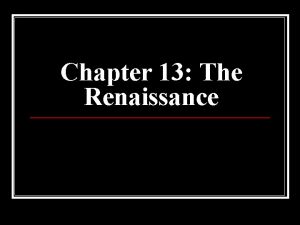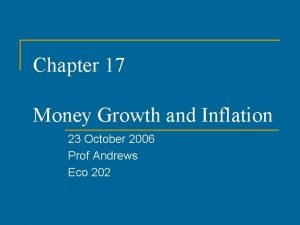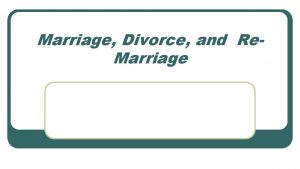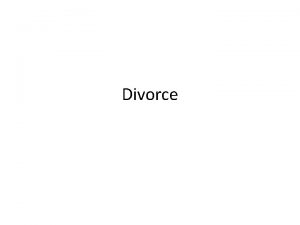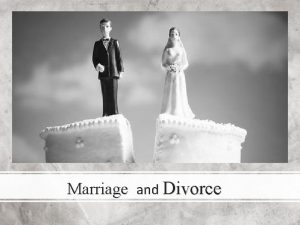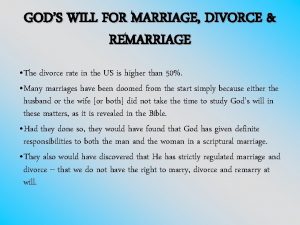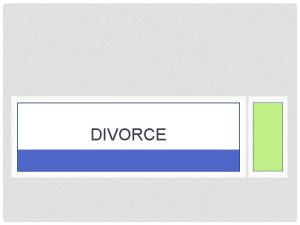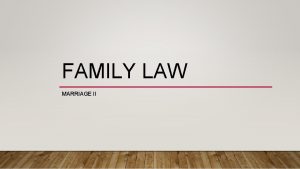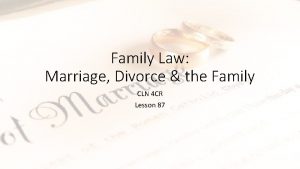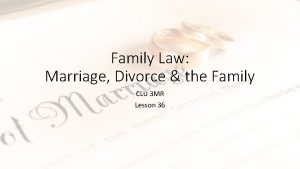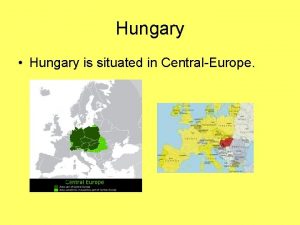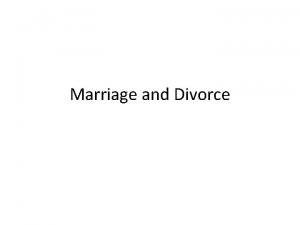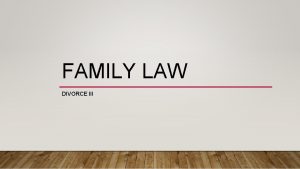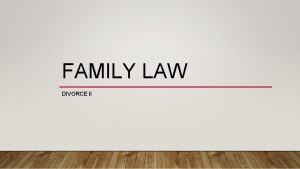Family structure across Europe Hungary Marriage Divorce In



















- Slides: 19

Family structure across Europe Hungary

Marriage Divorce • In Hungary, more and more people are divorced these days, while the number of marriages is decreasing. 1980 Today Marriages 80 000 40 000 Divorces 27 000 25 000 Married percentage 70 % (1980) 45 % Divorced percentage (1980) 10% 5%

To be or not to be? Since 1980, the birth rate has been decreasing and the death rate is increasing, as a consequence, the population is ageing.

Generations living together • Nowadays, two generations rarely live together • Some decades ago, grandparents, parents and children lived together.

The average Hungarian family • … in a city, lives in a housing estate. in the countryside, in a small detached house. • … is composed of 2. 6 people. • … has one medium-category car (Suzuki or Opel usually) • … has to commute every day to a city nearby. • … goes on holiday to Southern Europe for a long weekend. • . . . watches TV for 3 hours a day.

u t c s re ly i m G a m r e a f n u r t s

7

Nowadays about 40% of marriages will be divorced 8

9

The birthrate reached its maximum in the early 1960 s with 2, 5 children per woman to fall to about 1, 3 children today 10

The average German family • • 11 . . . in the city, lives in a 3 – 4 room apartment. . . in the countryside in a 2 floor house. . . drives a Volkswagen and an Opel. . . normally have cats as pets. . . have holidays in Germany. . . don‘t eat much „Sauerkraut“. . . and don‘t wear „Lederhosen“ 11

Bulgarian family structures

The average Bulgarian family • . . . consists of a father, mother and 2 children • . . . lives in an apartment which is around 70 m² big • . . . drive mostly one car which is often a Peugeot or Opel • . . . go on holiday r to the Black Sea

Divorces and Marriages Today Marriages 25, 923 Divorces 11, 662 Married percentage 3, 42 % Divorced percentage 1, 5 %

Norvegian family structure

Marriage Divorce • The last years it has been more usual to live together without being married. • There about 24 000 new marriages every year. • But 50 percent of them end in divorce.

Birth rate The number of births shows that every woman in average gives birth to 1, 95 children.

The average Norwegian family … The life expectancy are 79 years for men and 83 years for women, which is among the highest in Europe. … A family usually consists of a mom, a dad and about two children. … Most women are called Anne, Inger and Kari, and most men are named Jan, Per and Bjőrn. But today babies often get names like Emma and Lucas. … In the countryside they often got 2 cars, but in the city it’s more usual to use public transportation. Volkswagen and Toyota is the most popular cars.

The average Norwegian family … Over 80% of the population watches TV every day. … Norwegians use a lot of money on redecorating their houses. They also spend much money on hobbies. … It’s usual to own a cottage on the moutain or by the sea. … Almost 2 out of 3 lives in a detached house, and it’s more usual to own a house than to rent one.
 Marriage and divorce presentation
Marriage and divorce presentation Birth of the renaissance lesson 1 answers
Birth of the renaissance lesson 1 answers Usu mft
Usu mft Was austria hungary a country
Was austria hungary a country Fitorex
Fitorex Hungarian national costume
Hungarian national costume Hungary inflation rate 1946
Hungary inflation rate 1946 Hungary 896
Hungary 896 Lakes in hungary
Lakes in hungary Hungary inflation rate 1946
Hungary inflation rate 1946 Hungary age distribution
Hungary age distribution Hungary
Hungary Randstad hungary jobs
Randstad hungary jobs Iatefl hungary
Iatefl hungary Ericsson hungary
Ericsson hungary Morgan stanley hungary
Morgan stanley hungary Netherlands capital
Netherlands capital Cargo booking software
Cargo booking software Kju university hungary
Kju university hungary Sap labs hungary
Sap labs hungary

